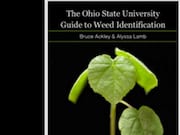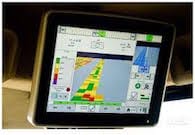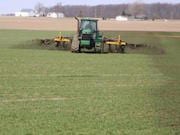Hello,
What a difference a week of warm weather makes. Soil temperatures are warming up and fields are starting to dry. Sprayers and fertilizer trucks are starting to roll. Spring planting season is almost upon us, providing the rain forecast later this week doesn’t slow things down. It is still early, and for northwestern Ohio, the probability for optimal yields occurs when corn is planted between April 25 and May 10. After this date, yields generally decline because of a shorter growing season. Corn planted before this time period will often have weakened or poor stands because of extended cool and wet conditions.
As you plan for burn down applications of herbicides and other weed control plans, remember that there is a free copy of the 2016 Weed Control Guide at http://agcrops.osu.edu/publications/ohio-and-indiana-weed-control-guide-bulletin-789 that you can look up answers and recommendations to your weed control questions. Many Extension offices are about out of this printed publication but you can download it for free. If you are not the type of person who likes to download files, I have attached a copy of the Tri-State Fertilizer Recommendations to this email. These are both great references to look up agronomic information and the price is right. Although this document was last published in 1995, it is packed with useful fertilizer recommendations for corn, soybean, wheat and alfalfa.
Tri-State Fertility Recommendations
This past growing year we had two Corn Response to Nitrogen test plots, with one near Alger and the other near Dola. l have attached an article I wrote about these two plots to this email. Although, last growing season wasn’t ideal with all of the rain and the resulting nitrogen loss, there were some patterns to the test strips of nitrogen rates. Read about the differences between 0, 50, 100, 150, 200, and 250 lb N application rates and the yield response to each in these plots. This year I am hoping to add nitrogen timing and hopefully N-P-K placement plots for on-farm research in Hardin County.
If you are a vegetable producer, you might be interested in the Midwest Vegetable Trial Report for 2015, which can be downloaded for free at https://edustore.purdue.edu/item.asp?Item_Number=16-18-15-W. If you are a dairy producer, you may be interested in attending the Dairy Cattle Welfare Symposium being held May 20th and 21st at The Ohio State University. See the attached document for more details and a registration link. Upcoming local events this week include a Soil and Water Conservation District board meeting on Thursday, April 21, starting at 7:30 am at the SWCD office. I have also included agronomy articles below for you to read if interested.
Mark
DIGITAL WEED IDENTIFICATION RESOURCES FROM OSU – Mark Loux
OSU has developed several digital books that are available for multiple platforms, via iTunes or GooglePlay. Descriptions and links follow – all are currently less than $10. The links can also be found under the “Weed ID” tab on our website – u.osu.edu/osuweeds/. The Ohio State University Guide to Weed Identification: This identification guide provides information on the basics of weed identification presented in a considerably updated fashion. It describes 29 families and 83 species of monocotyledonous and dicotyledonous plants. For more information about this and other weed ID resources, go to http://agcrops.osu.edu/newsletter/corn-newsletter/digital-weed-identification-resources-osu.
THE BIG DATA CONFUSION: PART 2 – EDUCATION – John Fulton, Kaylee Port
This week’s topic in “The Big Data Confusion” series touches on the importance of education. According to the Privacy and Security Principles for Farm Data, “Grower education is valuable to ensure clarity between all parties and stakeholders. Grower organizations and industry should work to develop programs, which help to create educated customers who understand their rights and responsibilities. ATPs should strive to draft contracts using simple, easy to understand language.” Producers should utilize any online fact sheets, brochures, and frequently asked questions pages for companies providing data services and tools. To read more about education’s role in understanding Big Data, go to http://agcrops.osu.edu/newsletter/corn-newsletter/2016-05/big-data-confusion-part-2-education.
TOPDRESSING WHEAT WITH LIQUID SWINE MANURE – Glen Arnold
Research on applying liquid livestock manure as a spring top-dress fertilizer to wheat has been ongoing in Ohio for several years. There is usually a window of time, typically around the last week of March or the first week of April, when fields are firm enough to support manure application equipment. The wheat fields have broken dormancy and are actively pulling nutrients from the soil. The key to applying the correct amount of manure to fertilize wheat is to know the manure’s nitrogen content. Most manure tests reveal total nitrogen, ammonia nitrogen and organic nitrogen amounts. To read more about topdressing wheat with liquid swine manure, go to http://agcrops.osu.edu/newsletter/corn-newsletter/2016-05/topdressing-wheat-liquid-swine-manure.
WHAT’S LIMITING SOYBEAN YIELD? – Laura Lindsey
As I travelled the state this winter, the same question came up, “What’s limiting soybean yield? No matter what I do, I get the same soybean yield every year.” With funding from the Ohio Soybean Council and North Central Soybean Research Program, I am embarking on a state-wide project aimed at generating some baseline producer data on current soybean management practices in Ohio’s production systems. The project goal is to identify key factors that preclude the state soybean producers from obtaining yields that should be potentially possible on their respective individual farms. Click on http://agcrops.osu.edu/newsletter/corn-newsletter/whats-limiting-soybean-yield to read more.
CALIBRATE YOUR SPRAYER NOW – HERE IS AN EASY WAY TO DO IT – Erdal Ozkan
Typically, I would wait until April to remind you to calibrate your sprayer, because of cold weather outside. But this year is not a typical year. Who would believe the temperature to reach 70’s in central Ohio today. There seems to be no better time to get the sprayer out of the shed and get it ready for the season. Check all the components of the sprayer to make sure they are in working order. Next step in preparations for the season is to calibrate the sprayer. The only way you can achieve maximum accuracy from a sprayer is by calibrating it once before the spraying season starts, and recalibrating it frequently throughout the spraying season. Go to http://agcrops.osu.edu/newsletter/corn-newsletter/2016-05/calibrate-your-sprayer-now-here-easy-way-do-it to finish reading this article.
Mark A. Badertscher
Agriculture and Natural Resources Educator
OSU Extension Hardin County
1021 W. Lima Street, Suite 103, Kenton, OH 43326
419-674-2297 Office





